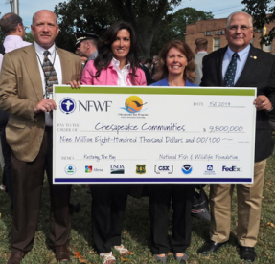The National Fish and Wildlife Foundation awarded PEC a $200,000 grant from the Chesapeake Bay Stewardship Fund this past October. With this grant, PEC will collaborate with Loudoun County, the Town of Lovettsville, Loudoun County Master Gardeners and Loudoun homeowners associations to implement projects that involve planting native trees and shrubs, improving stormwater facilities and reducing polluted runoff in Loudoun County communities.
Restoring Wildlife Habitat
Whether you live in urban, suburban or rural areas, you can make a positive impact on surrounding fish and wildlife populations. Our web resources are intended to give you the tools to manage your Piedmont lands and waters for greater biodiversity, productivity, and environmental quality.
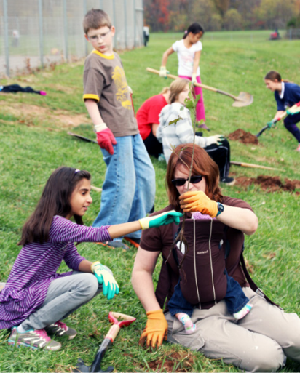
Planting the Seeds of Habitat Restoration
PEC teamed up with Mill Run Elementary School to create a naturally landscaped outdoor area for educating students, parents and the community. This past November, the school’s fourth and fifth grades participated in the project by planting 75 native trees and 135 native plants!
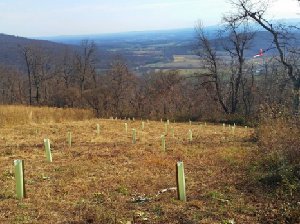
Two Thousand Trees Planted
An interview with PEC’s Sustainable Habitat Program Assistant Celia Vuocolo: What type of restoration happened at the Overlook this past fall? We did a large forest-edge planting of about 2,000 trees and shrubs. The goal was to create a “soft edge” where the forest meets the meadow…
Coyotes, Our Elusive Neighbors
For those of us old enough to remember when Looney Tunes ruled the afternoon cartoon television slot, the name Wile E. Coyote holds fond memories of a scrappy canine and his many failed attempts at catching the infamous and speedy Road Runner. To many children this was their first exposure to Canis latrans, who, next to the Gray Wolf, is North America’s other well-known and often misunderstood wild.
While Wile E. Coyote is known to prowl about on the flat, long desert highways of the American West, our Eastern coyote here in Virginia inhabits a different kind of backdrop. Coyotes are found in almost every environment in our state: forests, fields, suburbs, and city alleys. They are a notoriously secretive and seldom seen species. If you do happen to see a coyote, it is most likely due to chance, illness (such as rabies, mange, canine distemper, etc.), or because the animal has become desensitized to humans, which is often the result of either intentional or unintentional feeding.
Making Progress at the Piedmont Overlook
It’s been busy at the Overlook these past few months! PEC is in the final year of a cost-share agreement with the Natural Resources Conservation Service to improve the property’s habitat and increase its biodiversity. The marquee part of this grant is the creation of a 17-acre native grass and wildflower meadow on land that was formerly a pasture dominated by tall fescue.
Teaming Up to Save the “Brookie”
Virginia’s state fish, the eastern brook trout, is in trouble. The Commonwealth’s only native trout has seen a sharp decline in population due to a detrimental combination of rising temperatures, physical barriers to streamflow, pollution, and habitat loss. Many expect the species to be added to VA’s Wildlife Action Plan list in the near future.
Fall !
This is my kind of weather! Red maples turn their namesake, broad wing hawks and other raptor migrate south, white-tailed deer enter the rut, and so many more fun things. Speaking of deer, here's a copy of a recent article I wrote on deer abundance and wildlife habitat. This text was taken from an email sent out on September 20th, 2013:
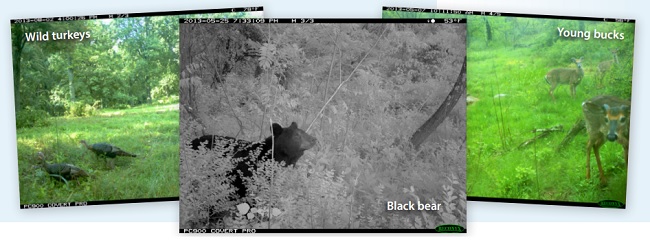
From the Field: PEC’s Piedmont Memorial Overlook
The first two steps in land management are to assess what condition the land is in and then decide what your goals are. PEC is going through both of these steps at the Piedmont Memorial Overlook—our 50-acre tract that straddles Clarke and Fauquier county.
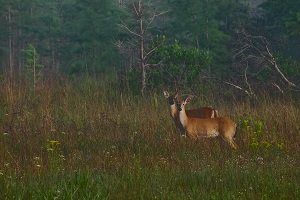
Oh Deer!
Fall is a busy time for wildlife in the Piedmont, particularly for mammals as they rush to prepare for the coming winter – storing food caches, finding mates, and burrowing den sites. During this time, white-tailed deer enter “the rut”: hormones rage, antlers grow, and males seek out females. Historically, it’s this time of year when you’re most likely to see deer, especially as bucks pursue does and the does play coy. Today, however, you are very likely to encounter deer any time of year — not just during the rut.
A Season Full of Activity
I hope you’re enjoying the delightfully cool spring. Personally, I’ll take all the cool weather I can get before the dog days of summer hit. Any cicadas in your neck of the woods? We'll see if the cool weather means that Brood 2 Cicadas will persist longer than usual. Check out this wonderful video on the life cycle of these fascinating creatures. This text was taken from an email sent out on June 6th, 2013:

